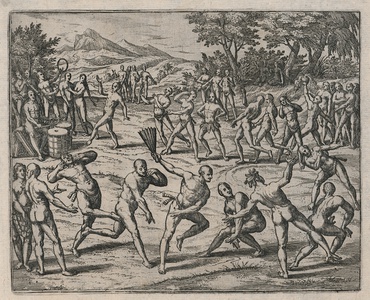| Method | Copper engraving |
| Artist | Theodor de Bry |
| Published | [Amsterdam, 1595] |
| Dimensions | Image 149 x 185 mm, Plate 151 x 186 mm, Sheet 328 x 230 mm |
| Notes |
Plate 21 from Part Five of the monumental Grande Voyages by Theodore De Bry. This plate is purportedly the first image to depict native Nicaraguans and is from the part of the Voyages which contains the descriptions of the Americas by Girolamo Benzoni (c. 1519- after 1572). A Milanese explorer, Benzoni spent 15 years travelling through the Spanish controlled areas of the Americas including the West Indies, Central America, and South America. After losing his fortune in a shipwreck, Benzoni returned to Italy penniless and he realised his only marketable asset was his experiences in the New World. Thus, he wrote Historia del Mondo Nuovo, which was published in Venice in 1565. His book eventually ran to eleven editions, the best known of which is De Bry's finely illustrated edition. The text for this plate reads: Each province organised its own festivities and people would come to a place if land therein, which had been swept clean for dancing. The dancers were accompanied by pipers, drummers and singers, while others would wave fans or rattles made from gourds, or shells tied to their legs and arms. During the dance they drank, contorted their limbs, screamed, feigned blindness of shyness and generally acted the fool. Everyone enjoyed themselves so much though, that the dancing sometimes went on for days and nights. Theodor de Bry (1528-1598) was a Flemish-born engraver and editor, who travelled Europe. De Bry fled from Liège in fear of the Spanish persecution of Protestants, lived in Strasbourg, travelled to Antwerp, then London, and finally settled in Frankfurt-am-Main, where he started a publishing business and printing workshop. de Bry's seminal work The Great and Small Voyages drew together contemporary narratives of exploration. Inspired and encourged by the English author Richard Hakluyt, de Bry completed the first part in 1590, and went on to publish five further parts before his death in 1598, when his wife and sons, Johann Theodor and Johann Israel, took over the task of completing the series. Immediately popular, drawing together a huge amount of material and in many cases providing the first readily available imagery of the new world and its inhabitants, this work and its illustrations provided the iconography and narrative of the peoples and customs of the Americas and the New World. The illustrations in the Voyages were in many cases based on existing images, but in many cases the images were altered to reflect European conventions, giving native peoples classical proportions and attributes. Condition: Repaired lower right corner of sheet and diagonal crease to lower right corner, neither affecting the image or plate. German letterpress text below image. Blank on verso. |
| Framing | unmounted |
| Price | £275.00 |
| Stock ID | 52624 |

